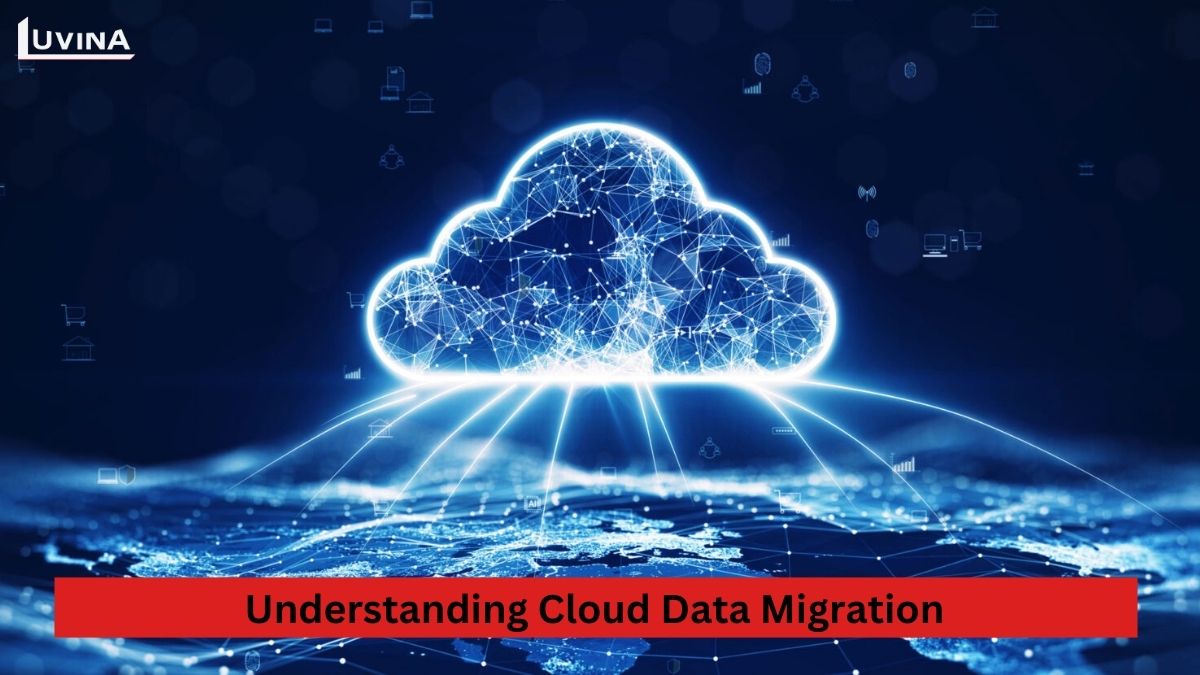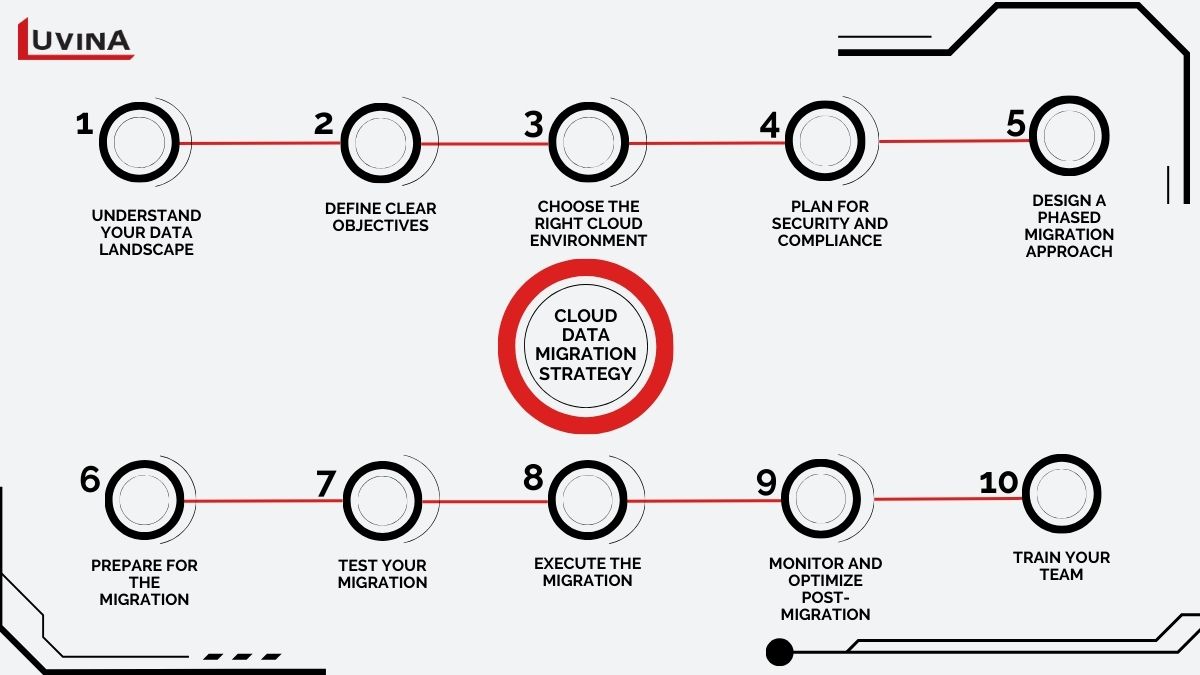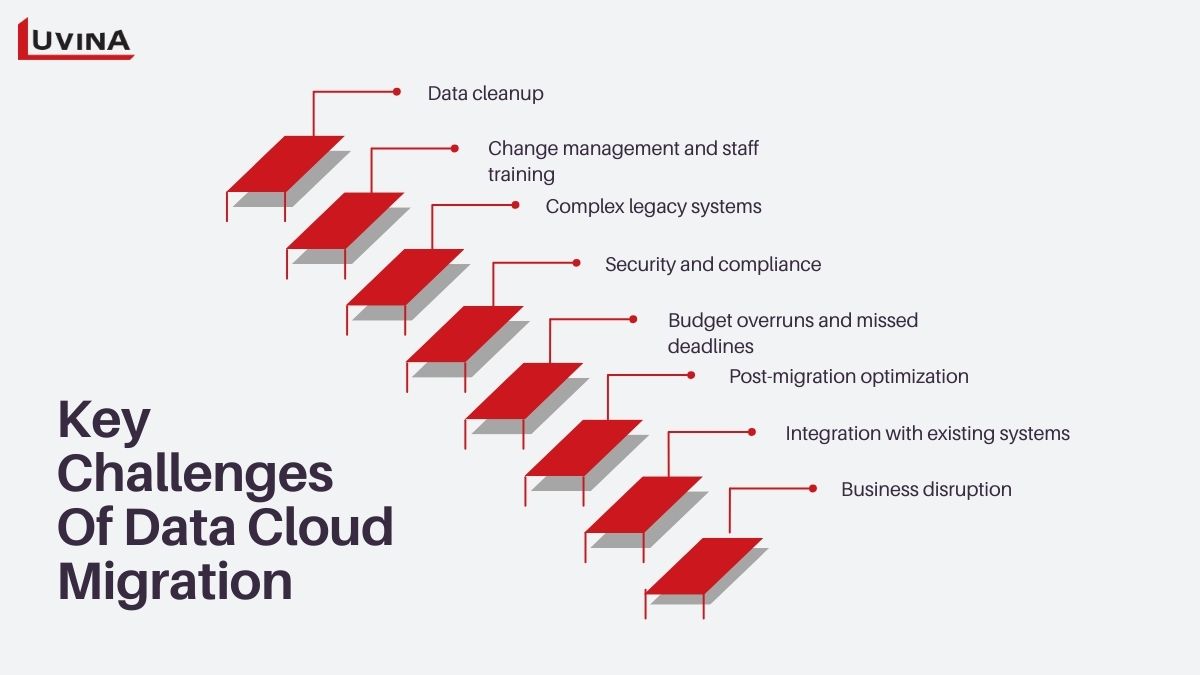Cloud data migration allows for unlimited storage and optimal use of computing resources. This is why many businesses are now adopting this method to quickly scale by leveraging the latest and most advanced technologies.
So, what exactly is data migration to the cloud and why is it important? In this article, we will provide key insights into cloud data migration services and offer useful tips on how to strategize and utilize tools for a successful transition.
What is cloud data migration?
Most businesses today understand that moving data to the cloud is essential for rapid scaling. But what exactly is this process?
Cloud data migration is the process of transferring all your data, applications, and other business components from an existing system to the cloud, or between different cloud environments. This move is popular because it can improve a business’s flexibility, scalability, and operational efficiency.

Cloud data migration is ideal for businesses looking to boost agility, reduce costs, and scale up effortlessly. This transition allows companies to manage their data and applications more flexibly, streamline operations, quickly adapt to market changes, and leverage the latest technologies like AI and analytics, driving innovation and growth.
Benefits of cloud data migration
In the process of digital transformation, cloud data migration can offer many significant benefits to businesses. Some key advantages include:
- Cost efficiency: Reduces the need for physical infrastructure and shifts IT costs to a more manageable operational model.
- Improved scalability: Allows businesses to easily adjust resources according to demand without heavy investments.

- Global accessibility: Supports remote work and enhances collaboration by making data and applications accessible from anywhere.
- Enhanced security and compliance: Leading cloud providers implement strong measures to protect data and ensure regulatory compliance.
- Access to advanced technologies: Helps businesses leverage cutting-edge technologies and maintain a competitive edge.
Cloud data migration strategy: Step-by-step
To ensure a smooth cloud data migration, you need a strong and secure strategy. Here are 10 detailed steps to create a strategy for this transition.

1. Understand your data landscape
The first step in your cloud data migration strategy is to thoroughly assess the data you plan to migrate based on factors like structure, sensitivity, and dependencies. Only by understanding your data can you create a complete migration strategy, ensuring you address the specific needs and challenges associated with it.
2. Define clear objectives
You need to answer why you are migrating data to the cloud—whether it’s to increase business agility, reduce costs, or improve data analytics capabilities. Your objectives will guide the strategy. Clear goals will help you measure the success of the migration and align it with business needs.
3. Choose the right cloud environment
Selecting the appropriate cloud environment is crucial. Consider factors like scalability, performance, and cost. Evaluate different cloud providers to determine which one best fits your needs by considering their services, support, and compliance with industry standards.
4. Plan for security and compliance
When planning your cloud migration, to ensure data safety and compliance, you need to develop a comprehensive plan. You should also choose a cloud provider that meets industry standards and implements strong security measures to protect sensitive information during and after the migration.
5. Design a phased migration approach
Breaking the migration into manageable phases will help you manage it better and quickly troubleshoot any issues, reducing the risk of business disruption. Additionally, a phased approach allows for thorough testing of each phase and ensures the migration process is controlled and systematic.
6. Prepare for the migration
To prepare for the migration, set up the cloud environment, configure storage and databases, and establish a backup and recovery process. This is also the stage to clean and organize your data to ensure that only necessary and high-quality data is migrated, optimizing the cloud environment.
7. Test your migration
Before the official migration, conduct thorough testing to ensure data integrity and application performance. Testing should be done in a controlled environment to minimize the impact of any issues. This step is crucial to identify potential problems and fix them before the final migration.
8. Execute the migration
This is the stage to carry out the cloud data migration according to the planned phases. Monitor the migration closely to detect and address any issues quickly. Close oversight ensures any disruptions are minimized and the migration stays on track.
9. Monitor and optimize post-migration
After the migration, continue to monitor the cloud environment. This allows you to optimize resources, manage costs, and improve performance. Regular monitoring helps identify any anomalies and ensures the cloud environment is running efficiently.
10. Train your team
Ensure your team is well-trained on the new cloud environment. Effective use and management of the cloud are crucial to realizing its benefits. Training helps maximize the potential of the cloud services and ensures the team can handle the new system competently.
Key challenges of data cloud migration
The process of cloud data migration is not simple and can be time-consuming and costly, especially if the business cannot identify and address some of the following challenges:

- Data cleanup: Cleaning up data before migration is essential. Ensure that only the most accurate and relevant data is transferred. The cleaner the data, the lower the migration costs and the higher the efficiency.
- Change management and staff training: Comprehensive change management strategies and adequate training are crucial for a smooth transition. Without this, employees may struggle to adapt to new processes.
- Complex legacy systems: Migrating from complex legacy systems to the cloud can be challenging, as these systems may not be readily compatible with modern cloud services.
- Security and compliance: If security and regulatory compliance are not maintained, businesses can face legal issues.
- Budget overruns and missed deadlines: Complex cloud migration projects can easily exceed initial timeframes and budgets.
- Post-migration optimization: Optimizing the new cloud environment after migration is necessary to ensure efficient and cost-effective operation.
- Integration with existing systems: Without careful planning and testing, migrated data will struggle to integrate seamlessly with existing systems.
- Business disruption: Cloud data migration can lead to operational downtime, causing business disruption. Minimizing this downtime is crucial to prevent significant losses.
Cloud data migration tools
To successfully migrate data to the cloud, leveraging the right tools is crucial. These tools provide various approaches and features to ensure smooth and efficient data migration.
1. AppDynamics
AppDynamics is designed to provide real-time performance monitoring, making it easier to track how your applications perform and how users experience them. Key features like application mapping and performance baselining are particularly useful, as they allow you to see the structure and dependencies of your applications both before and after migration. This visibility helps in detecting any anomalies and understanding how migration impacts user experience and business outcomes.
2. AWS Migration Services
AWS Migration Services, which encompasses AWS DMS, Server Migration Service, and Migration Hub, is a top choice for cloud data migration. This suite of tools supports a wide range of database migrations and ensures data synchronization through continuous replication. It also facilitates the seamless transition of server workloads to AWS, making it a comprehensive solution for handling complex migration needs.
3. AvePoint Migration
AvePoint Migration provides a unified platform for migrating diverse data types, including files and emails, to the cloud. It features detailed migration mapping, scheduling, and reporting, ensuring minimal downtime through continuous data synchronization.

4. Azure Migrate
Azure Migrate provides robust support for evaluating and moving on-premises workloads to Azure. It simplifies the migration process by offering detailed visualization of application dependencies, cost estimation, and performance recommendations. Whether you’re migrating servers, databases, web applications, or virtual desktops, Azure Migrate is equipped to handle these tasks with minimal risk.
5. Carbonite Migrate
Carbonite Migrate automates the migration of physical, virtual, and cloud workloads with minimal disruption. It features continuous replication to maintain data consistency and supports migration across different systems without vendor lock-in.
>> Also read: How to Choose the Right Cloud Service Development Tools
How can we help?
Planning your cloud migration strategy is essential for a successful transition. Equally important is selecting the right cloud provider. If you’re considering cloud migration, reach out to Luvina, a leading IT solutions company in Vietnam. Experience the power of cloud data migration services and unlock your business’s full potential with our professional IT outsourcing solutions today.
We currently offer cloud migration services using the re-hosting method. This approach provides a quick and cost-effective migration solution, with benefits including reduced costs and improved security.

Recently, Luvina undertook a significant cloud migration project in collaboration with a leading IT service provider in Japan, aiming to transform their CRM system for small and medium enterprises (SMEs). This project involved rehosting their existing system into a sophisticated setup of 18 microservices, each requiring independent operation while maintaining seamless connectivity. A critical requirement was the ability to rapidly restore data in the event of technical issues, a challenge complicated by the intricate nature of microservices.
To address these complexities, we engaged experts who provided valuable insights and solutions for managing data flow and recovery in a microservices environment. Additionally, we implemented a comprehensive logistics system to support over 100 team members working in shifts, ensuring their well-being and maintaining productivity despite pandemic constraints.
The results were highly successful: we overcame the data recovery challenges, delivering a system with advanced functionality and robust data recovery capabilities. We also maintained a rigorous quality standard, achieving an impressive 0.7% error rate, exceeding client expectations, and setting a new benchmark for quality.
With over 20 years of experience, Luvina excels as an ISO 9001-certified leader, providing top-tier software services. Our team of 750+ skilled developers is adept at cutting-edge technologies, ensuring stable software operation. We also adhere to international security standards like ISO 27001, guaranteeing the confidentiality and security of your data and IP.
Save time and money with Luvina’s cloud data migration services! Contact us for more detailed information.nt support, please contact Luvina for detailed advice.
Related Posts:










Read More From Us?
Sign up for our newsletter
Read More From Us?
Sign up for our newsletter